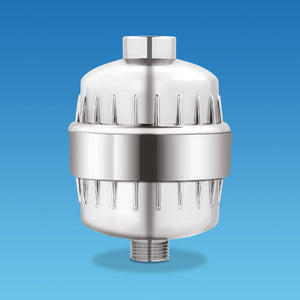Have you ever noticed that the flow from some shower heads is stronger than others? There is more than just water pressure at work when taking a shower.
The amount of water moving through your shower, measured as your shower head GPM makes a big difference in your shower experience and utility bills. Below, we explore the differences between these shower heads and share some tips for creating the perfect shower experience for your home with AquaBliss.
What does GPM mean for shower heads?

GPM (Gallons per Minute) measures the gallons of water passing through your shower head per minute. The higher the GPM of water in your shower, the stronger the flow will likely feel.
By creating lower GPM shower head options, we can reduce the water used during every minute of your shower, saving resources and lowering utility bills.
Why is shower head GPM or flow rate important?
Cost savings and environmental concerns are only a couple of reasons you should think about your shower GPM. State regulations vary across the country and knowing your local rules is crucial for your next bathroom upgrade.
People who need a powerful flow should also take note of the GPM of their shower head. You may miss out on better rinsing and cleaning power if your GPM is too low for your needs.
What are some state and local government limits on GPM?
Some states have laws regulating the maximum GPM of shower heads. At this time, residents of California, Washington, Oregon, and Hawaii are limited to using low-flow 1.8 GPM shower heads. New York, Massachusetts, Colorado, Maine, Vermont, and Rhode Island require shower heads to stay under 2.0 GPM.
How do you figure out your shower’s GPM?
Most shower head models will list the GPM of the product within the packaging, product description, or installation manual. To find out the GPM of an older shower head, you can measure it the old-fashioned way, by collecting water.
To measure the gallons of water per minute passing through your shower, simply set a ten-second timer and collect the flowing water in a bucket. Multiply the volume of collected water by 6, to get the water flow per minute (10 seconds x 6 = GPM rate).
What's the difference between flow rate and water pressure?

Water flow rate and water pressure can be related, but they are not the same thing. The water flow rate is the amount of water that passes through your shower in a set time frame. We use gallons per minute, or GPM as a standard measurement.
Water pressure measures the force used to push your water through the pipes. If a shower head has a high GPM rating, allowing a lot of water to pass through, low water pressure can still prevent the flow from reaching the desired level.
Water pressure can be affected by several plumbing issues, including:
- Clogged pipes: Blockages and the build-up of mineral deposits can create a narrowing of your pipes, reducing the amount of water that can travel to your shower per minute.
- Leaking: If your water pressure reduces over time, a leak within your plumbing can be to blame.
- City regulations: When your water supply comes from the city, some things are outside your control. Many local regulations limit water pressure levels to conserve energy and water.
What is the highest GPM shower head?
In the US, a federally mandated law restricts the water flow from a shower to a maximum of 2.5 GPM. This restriction helps to conserve water while allowing for powerful rinsing and effective cleaning. Some states further restrict shower head GPM, so checking your local rules is vital.
What is better, a 1.8 or 2.5 GPM shower head?

At AquaBliss, both efficient 1.8 GPM and powerful 2.5 GPM shower heads are available. But what is the difference? We take a look at these two great options.
The efficient 1.8 GPM shower head
A 1.8 GPM shower head is considered a low-flow design, saving a significant amount of water each time you take a shower. These low-flow shower heads are a great choice for customers who want to:
- Save money: Showers make up a big part of your water bill. By saving water every minute, you can spend less on utilities.
- Conserve water: A big plus for environmentally conscious shoppers and vital for people who live in drought-prone areas.
- Follow government regulations: If local regulations restrict shower GPM, a high-quality efficient model can still provide a powerful shower experience with good water pressure.
The more powerful 2.5 GPM shower head
Traditional 2.5 GPM shower heads provide more water per minute, offering a stronger shower experience when combined with good water pressure. Less efficient than 1.8 GPM alternatives, these shower heads offer:
- Better rinsing: With a more powerful flow, some people actually discover they shower more quickly using a shower head with a higher GPM. Faster rinsing and hair washing can speed up the process and still offer efficient showering.
- Faster warming: As the cold water runs through the shower before wonderful hot, steamy water follows, a shower head with a higher gallon-per-minute rate can speed up the process and get you into a warm shower much faster.
- A variety of shower settings: With a higher flow rate, a 2.5 GPM shower head can offer more options for a soothing shower, with spa-like massaging.
What is the best GPM for a shower head?

Water-efficient 1.8 GPM shower heads and 2.5 GPM models both have benefits and downsides. To select the right model for your home, consider the following:
- Your location: If you live in a state with additional restrictions, a low-flow shower head may be your only choice. With a high-quality shower head from AquaBliss
- Water pressure: The water pressure in your home plays a major part in the flow of your shower water. If your water quality and pressure is good, an efficient 1.8 GPM shower head can provide more than enough rinsing power.
- Budget: If keeping the bills as low as possible is a priority for your home, a lower GPM shower head can help squeeze out the best savings.
- Personal needs: For people with long and thick hair, or those who enjoy home spa treatments, the rinsing power of a higher GPM shower head can actually speed up your overall shower time.
- Environmental concerns: A low-flow shower head can reduce water usage when you keep your showers short. If saving local water is a priority, an efficient model may be a better choice.
Final Thoughts
Knowing the basics about water flow can help you maximize your shower experience and keep your home as efficient as possible. Whether you choose a money-saving 1.8 GPM shower head, or prefer the stronger rinsing power of a 2.5 GPM model, the key to creating your ideal bathroom oasis is the quality of your shower head.
At AquaBliss, we create products for the best shower experience, no matter which flow rate you select. With spa-like options and water-conserving designs, upgrade your bathroom with an AquaBliss shower head and filters today!







